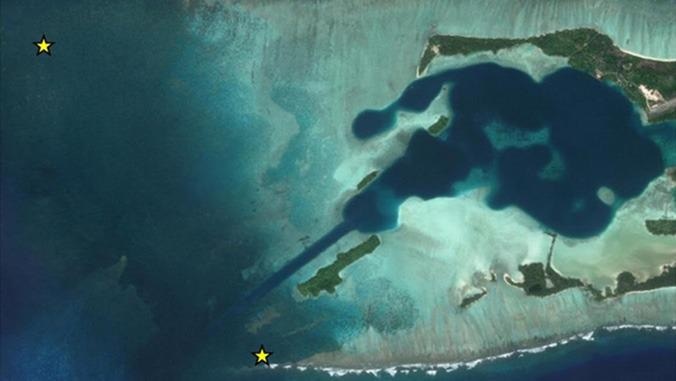The coral reefs thriving in Palmyra Atoll, a small outlying atoll in the equatorial Pacific Ocean, have been transforming from stony corals to systems controlled by corallimorphs—marine invertebrates that share genes with both hard corals and anemones.
 A map of Palmyra Atoll showing where the corallimorphs were collected. Image Credit: Kaitlyn Jacobs.
A map of Palmyra Atoll showing where the corallimorphs were collected. Image Credit: Kaitlyn Jacobs.
A new study published in the journal Coral Reefs and led by marine biology researchers from the University of Hawaiʻi at Mānoa identified that the invading corallimorphs have been in existence for decades but have recently transformed into something more insidious.
These kinds of phase shifts are noticed in numerous marine environments worldwide, occurring either due to global climate change, local pollution, or natural environmental variations. Scientists from UH Mānoa’s School of Ocean and Earth Science and Technology (SOEST) are working to confirm whether a new species of corallimorphs was responsible for occupying the Palmyra region.
These phase shifts are negative to our overall biodiversity. In the last decade, Palmyra’s nearshore reefs have been invaded by corallimorph colonies that can rapidly monopolize the seafloor and reach 100% cover in some areas.
Kaitlyn Jacobs, Study Lead Author and Graduate Student, Institute of Marine Biology, School of Ocean and Earth Science and Technology, University of Hawaiʻi
Out-competing Surrounding Corals
Jacobs and her colleagues employed DNA data to compare the mitochondrial genomes of four corallimorph specimens taken from Palmyra Atoll. They observed that the corallimorph out-competing the other corals is not a new species. Instead, it is a near relative to those obtained from Okinawa, Japan.
The Palmyra Atoll National Wildlife Refuge was established in 2001 and is being protected to date. The Atoll was declared a nearly pristine coral reef ecosystem and assists a greatly productive ecosystem with high levels of coral cover.
Corallimorphs have become excellent competitors due to their adaptability factor. Apart from killing the corals directly, they can rapidly travel into disturbed regions and out-compete surrounding organisms, forming a kind of blanket on the reef.
There is concern among scientists and conservationists that the phase shift from stony coral-dominated habitats may be irreversible due to a negative feedback loop of coral decline and subsequent algal, sponge or corallimorph domination.
Kaitlyn Jacobs, Study Lead Author, and Graduate Student, Institute of Marine Biology, School of Ocean and Earth Science and Technology, University of Hawaiʻi
This attempt exemplifies UH Mānoa’s aim of Excellence in Research: Advancing the Research and Creative Work Enterprise, one of four goals determined in the 2015–2025 Strategic Plan, updated in December 2020.
Journal Reference:
Jacobs, K. P., et al. (2021) A phylogenomic examination of Palmyra Atoll’s corallimorpharian invader. Coral Reefs. doi.org/10.1007/s00338-021-02143-5.